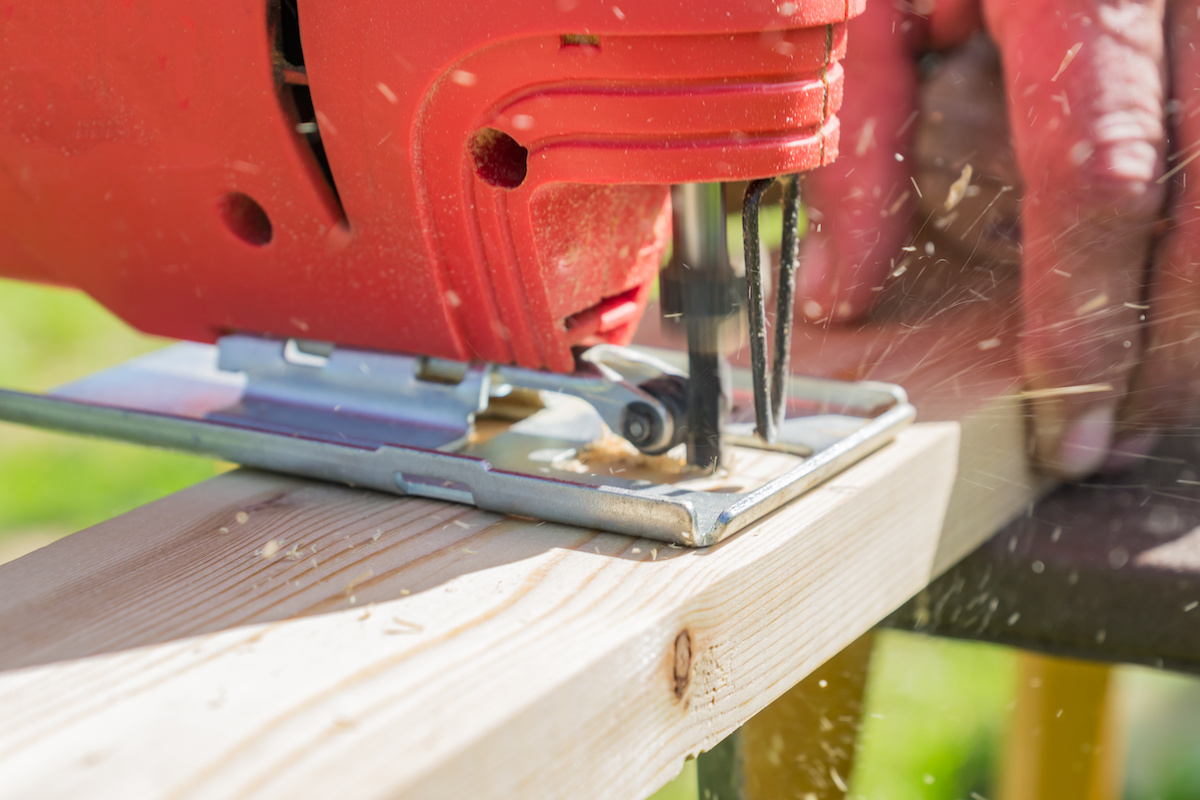Jigsaws are a fantastic tool for the average carpenter and home DIYer alike. They are also sometimes referred to as saber saws. Jigsaws are great for cutting irregular shapes such as curves as well as miter or rip cuts. It is important to know how to use a jigsaw correctly so that you don’t injure yourself.
Jigsaw Safety Precautions
Always wear a dust face mask and eye protection when using a jigsaw. This will protect you from dust particles in the air that come from cutting wood and plastic.
Unless you are using a cordless jigsaw, you should be careful of the power cable. It would be very dangerous to accidentally cut through the cable with the jigsaw blade. A good tip is to wrap the cable around your forearm when correctly using the jigsaw. This helps to keep the cable away from the saw blade. Also always make sure your jigsaw is unplugged when changing the blade.
How to Cut with a Jigsaw
A jigsaw works by moving a blade up and down at high speed. The blade is connected to a motor and mechanism that allows for this movement and makes cutting wood, metals, and plastic a breeze.
Even complex shapes and curves are no problem as the small width of the blade allows it to follow any path.
Your Cutting Area
When correctly using a jigsaw think about where you are going to do the majority of your work. If you don’t have a dedicated workshop or garage then there is no reason why you can’t cut outside.
Set up a workbench that is at suitable working height and is secure. Remember that cutting plastic and wood will generate a lot of dust so it is a good idea to use your jigsaw in a well-ventilated area.
Essential Accessories
Other than the safety measures we have already mentioned there are a few other items to have at hand. It is important to be able to hold your materials securely for cutting so make sure you have a couple of clamps. A set square is essential for making sure you are making 90-degree cuts. And of course, we never go anywhere without a trusty pencil or another marking device.
The Jigsaw Cutting Process
- Mark up your material as to where your cut needs to be.
- Using a clamp secure the material to a workbench.
- Make sure your jigsaw has a suitable blade installed and is powered on (or charged up)
- Place the jigsaw at the edge of your material resting on the base plate. Make sure the blade isn’t touching yet but is in line with the desired cutting point.
- Gently pull the trigger and allow the jigsaw to get up to full speed before moving the jigsaw forwards.
- Continue to move the jigsaw forward following your cutting mark.
- Always work slowly and let the blade do the cutting. You shouldn’t need to apply much pressure at all.
- At the end of your cut release the trigger and allow the blade to stop moving completely before setting aside.
- It is a good idea to switch off your jigsaw and unplug it from power.
Straight Jigsaw Cuts
A jigsaw is great for making rip cuts or crosscuts. Check that your blade length is suitable to go through the thickness of the wood, it should protrude at least an inch.
It is a good idea to use an edge guide to make a perfectly straight cut. Some jigsaws come with their own attachment edge guides.
If not then a set square can also be useful for marking up your cutting line. Set the square on the edge of the material, using the lip to make sure it is flush. Then run your marker along the edge you are looking to cut.
Squares can also be clamped in to position and your jigsaw run along the edge. Using the square as a guide against the base plate.
Angle Cuts with a Jigsaw
A 45 degree cut is a common cut that is need in woodworking. It is great for building boxes, shelves and more.
To make an angle cut with a jigsaw you have to adjust the base plate. Remove the screws that are holding it into place and rotate the plate to your desired angle. Replace the screws using an Allen key, making sure that the plate is held securely in place.
An angle cut is made in the same way that a straight cut is, however extra caution should be made to check that your blade is long enough to cut through at an angle. Also, keep an eye on which direction of the angle you are trying to cut.






